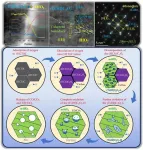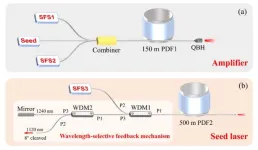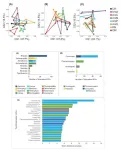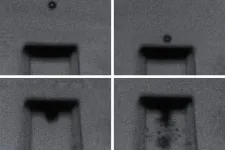(Press-News.org) There is substantial geographic variation across the U.S. health care system to diagnose and treat early-stage Alzheimer’s disease with disease-modifying therapies, and engaging primary care providers in the effort may be a key to accelerating delivery of emerging new treatments, according to a new RAND report.
Enabling primary care practitioners to diagnose and evaluate patients for treatment eligibility would make the biggest impact on reducing wait times for specialists and increase the number of people treated with disease-modifying therapies from 2025 through 2044.
While primary care providers are technically capable of performing cognitive assessments, most do not do them regularly because of time constraints with competing demands, according to the report. Creating new training for primary care providers, improving reimbursement rates, and developing guidelines to streamline workflows would all be key to making such a change.
Additionally, improved triage of patients using blood-based biomarker tests could further reduce caseloads for specialists, according to researchers.
The recommendations are part of a report that assesses the regional capability of the U.S. health care system to deliver disease-modifying therapies for Alzheimer’s that have begun to be approved.
The report finds that the states with the longest expected wait times for diagnosis are Alaska, Arkansas, Idaho, Mississippi, Montana, Nevada, Oklahoma and Wyoming -- largely the result of low levels of dementia specialists as compared to the number of residents aged 50 and older. Estimated average wait times can be three times longer in rural areas as compared with urban areas.
“System-level barriers may mean that people with early-stage Alzheimer’s would not benefit from the therapies that could delay disease progression,” said Jodi Liu, the report’s lead author and a senior policy researcher at RAND, a nonprofit research organization. “Our analysis suggests that strategies are needed to ease the demand on specialists for evaluation and diagnosis of cognitive impairment.”
An estimated 12.1 million people in the U.S. have mild cognitive impairment, which could be signs of Alzheimer’s or other illnesses.
The widespread availability of effective disease-modifying therapies would be a breakthrough in slowing the progression of early-stage Alzheimer’s disease but would create large challenges to the health care system to screen, diagnose, and treat patients.
Two disease-modifying Alzheimer’s therapies have received approval from the U.S. Food and Drug Administration (one with traditional approval and one with accelerated approval), and more candidates are in late-stage clinical trials. But questions remain about how these therapies will be priced, covered by insurance, and delivered.
RAND researchers used a simulation model to assess patient demand and provider supply for the delivery of Alzheimer’s disease-modifying therapies, expanding on earlier RAND work that looked at the preparedness of the health care system before any such therapies were in clinical use. The model assessed items such as the number of medical specialists, availability of PET scanners used to confirm a diagnosis of Alzheimer’s, and the workforce needed to deliver the intravenous infusion treatments.
The new analysis includes an assessment of the capacity of primary care practitioners to perform brief cognitive assessments, analyzing the impact that patient use of those assessments in primary care settings would have on the delivery of therapies. Such a move would help curb the demand on neurology and geriatric practices, which often already have wait lists for appointments, from the expected surge in people seeking new treatments.
In addition, the new modeling uses county-level information to illustrate the geographic variations in patient populations and health care system capacities. Using this information, the research team created an interactive tool that allows users to vary patient demand and provider capacity assumptions and to view the county-level capacity for key resources such as medical specialists and PET scanners.
“Our estimates are not meant to predict exactly what treatment delivery will look like, but to provide feasible scenarios that can help inform where bottlenecks may occur and identify areas where attention may be needed to prepare the health care system.” Liu said.
Researchers say that further work is still needed to evaluate how primary care-led models of care can widely and effectively evaluate and manage treatment for people with early-stage Alzheimer’s. Other work should evaluate how technological advancements, such as improved biomarkers and computerized testing, can be integrated into workflows to better serve patients.
Reimbursement levels for disease-modifying therapies will have a critical influence on patient uptake of therapies and on provider decisions to allocate resources to detect, diagnose, and treat eligible patients.
“Widespread delivery of disease-modifying therapies for Alzheimer’s will require a combination of strategies to communicate the value of detection and treatment to patients, integrate primary care providers into the detection and diagnosis system, and address geographic disparities in the health care system capacity across the nation,” Liu said.
Support for the report was provided by Genentech.
The report, “Modeling Early Detection and Geographic Variation in Health System Capacity
For Alzheimer’s Disease-Modifying Therapies,” is available at www.rand.org. Other authors of the report are Lawrence Baker, Annie Chen, Jessie Wang, and Frederico Girosi.
RAND Health Care promotes healthier societies by improving health care systems in the United States and other countries.
END
Alzheimer’s treatment roadblocks can be eased by engaging primary care providers in screenings
Study finds substantial variation across U.S. to diagnose and treat early-stage Alzheimer’s disease
2024-01-30
ELSE PRESS RELEASES FROM THIS DATE:
New study identifies link between presence of oncofoetal ecosystem and liver cancer recurrence
2024-01-30
A new causal link has been found between the presence of oncofoetal ecosystems and recurrence and response to immunotherapy in primary liver cancer, hepatocellular carcinoma (HCC)
The findings will pave the way to use the presence of oncofoetal ecosystems as a biomarker to treat HCC, a disease with a poor prognosis that is typically diagnosed late
Singapore, 30 January 2024 - A team of clinician-scientists and researchers from the National Cancer Centre Singapore (NCCS), Agency for Science, Technology and Research (A*STAR), the Harry Perkins Institute of Medical Research and global research partners, has found a causal link between the presence of oncofoetal ...
Unveiling the effect of Ti substitutions on the static oxidation behavior of (Hf,Ti)C at 2500 ℃
2024-01-30
Hf-based carbides are highly desirable candidates for thermal protection applications above 2000 ℃ due to their extremely high melting point and favorable mechanical properties. However, as a crucial indicator for composition design and performance assessment, the static oxidation behavior of Hf-based carbides at their potential service temperatures has been rarely studied.
In a study published in the KeAi journal Advanced Powder Materials, a group of researchers from Central South University and China Academy of Launch Vehicle Technology revealed the static oxidation mechanism ...
High power fiber laser at 1.2 μm waveband
2024-01-30
Laser sources operating at the 1.2 μm wavelength band have some unique applications in photodynamic therapy, biomedical diagnosis and oxygen sensing. Additionally, they can be adopted as pump sources for mid-infrared optical parametric generation as well as visible light generation by frequency doubling. Laser generation at 1.2 μm waveband has been achieved with different solid-state lasers including semiconductor laser, diamond Raman laser, and fiber laser. Among these three types, fiber laser thanks to its simple structure, good beam quality, and operation flexibility, is a great choice for 1.2 μm waveband laser generation.
Researchers ...
Integrated design of Global Ocean Observing System essential to monitor climate change
2024-01-30
We know that our climate is changing. Extreme weather events are becoming more common, sea levels are rising and overall, our planet is getting warmer. Monitoring these changes is critical. One of the best indicators of climate change is the Ocean Heat Content (OHC) estimate, a measurement of overall oceanic temperature calculated by gathering water temperature data in oceans around the world in differing locations, at varying depths and across time. The data necessary to calculate the OHC over such a wide-spread area is gathered by the Global Ocean Observing System (GOOS), an integrated network of platforms ...
Nitrogen-based fertilizers differentially affect protist community composition in paddy field soils
2024-01-30
Soil microbiome has far-reaching significance, particularly for rice production, which can be better explained with a Japanese proverb: “Rice grows with soil fertility, while upland crops depend on fertilization”. Therefore, understanding the paddy field microbiome is crucial for sustainable soil fertility and rice production. This would also lead us to overcome the global food shortage problem as rice is the primary food source for nearly half of the world's population. Among the paddy field microbes, bacteria, fungi, and archaea are well-studied, while protists, the vast majority of eukaryotes, are largely unknown. Protists are the most diverse eukaryotic microorganisms ...
Systemic US reforms needed to prevent mass death in the next pandemic
2024-01-30
Ahead of the 2024 US presidential election, The BMJ today launches a forward-looking series that highlights the lessons that can be learned from the US’s covid-19 experience and the actions that are needed to prevent the loss of another million citizens in the next pandemic and improve and protect population health.
The articles, written by leading clinicians and researchers across the US, explore topics such as how systemic racism and economic inequality contributed to covid-19 disparities; mass incarceration and poor prison health as a driver of the pandemic; ...
U.S. regulatory system failed to prevent thousands of deaths in frontline workers during the pandemic
2024-01-30
An analysis published today in the The BMJ examines the risks faced by frontline workers in the United States during the pandemic and suggests reforms that could protect population health and save lives.
Lead author Professor David Michaels at the George Washington University and his colleagues note that from the onset laws and regulations in the United States inadequately protected frontline workers. The gaps allowed a rapid spread of disease in US workplaces like meat packing plants. At the same time, these essential workers were rarely seen as a population that needed special attention ...
Innovative school Citizen Science project involving over 1000 scientists, 110 schools, 800 samples and U.K.’s synchrotron published in CrystEngComm
2024-01-30
Results of a large-scale innovative Citizen Science experiment called Project M which involved over 1000 scientists, 800 samples and 110 UK secondary schools in a huge experiment will be published in the prestigious RSC (Royal Society of Chemistry) journal CrystEngComm on 29 January 2024. The paper is titled: “Project M: Investigating the effect of additives on calcium carbonate crystallisation through a school citizen science program”. The paper shares a giant set of results from the school citizen scientists who collaborated with a team at Diamond to find out how different additives affect the different forms of calcium carbonate produced. These additives affect the ...
Probiotics promote weight loss in obese dogs
2024-01-29
Washington, D.C.—Researchers have identified 2 strains of probiotics that can be used to reduce weight in obese dogs. The research is published this week in Microbiology Spectrum, a journal of the American Society for Microbiology.
In the new study, the research team investigated metabolic diseases in companion animals and set out to identify probiotics suitable for long-term and safe treatment. “The initial challenge involved selecting specific metabolic diseases for examination, leading us to focus on the prevalent issue of 'obesity in pets,’” said study principal investigator Younghoon Kim, Ph.D., professor in the ...
Benchtop test quickly identifies extremely impact-resistant materials
2024-01-29
CAMBRIDGE, MA – An intricate, honeycomb-like structure of struts and beams could withstand a supersonic impact better than a solid slab of the same material. What’s more, the specific structure matters, with some being more resilient to impacts than others.
That’s what MIT engineers are finding in experiments with microscopic metamaterials — materials that are intentionally printed, assembled, or otherwise engineered with microscopic architectures that give the overall material exceptional properties.
In a study appearing today in the Proceedings of the National Academy of Sciences, the engineers report on a new way ...
LAST 30 PRESS RELEASES:
Injectable breast ‘implant’ offers alternative to traditional surgeries
Neuroscientists devise formulas to measure multilingualism
New prostate cancer trial seeks to reduce toxicity without sacrificing efficacy
Geometry shapes life
A CRISPR screen reveals many previously unrecognized genes required for brain development and a new neurodevelopmental disorder
Hot flush treatment has anti-breast cancer activity, study finds
Securing AI systems against growing cybersecurity threats
Longest observation of an active solar region
Why nail-biting, procrastination and other self-sabotaging behaviors are rooted in survival instincts
Regional variations in mechanical properties of porcine leptomeninges
Artificial empathy in therapy and healthcare: advancements in interpersonal interaction technologies
Why some brains switch gears more efficiently than others
UVA’s Jundong Li wins ICDM’S 2025 Tao Li Award for data mining, machine learning
UVA’s low-power, high-performance computer power player Mircea Stan earns National Academy of Inventors fellowship
Not playing by the rules: USU researcher explores filamentous algae dynamics in rivers
Do our body clocks influence our risk of dementia?
Anthropologists offer new evidence of bipedalism in long-debated fossil discovery
Safer receipt paper from wood
Dosage-sensitive genes suggest no whole-genome duplications in ancestral angiosperm
First ancient human herpesvirus genomes document their deep history with humans
Why Some Bacteria Survive Antibiotics and How to Stop Them - New study reveals that bacteria can survive antibiotic treatment through two fundamentally different “shutdown modes”
UCLA study links scar healing to dangerous placenta condition
CHANGE-seq-BE finds off-target changes in the genome from base editors
The Journal of Nuclear Medicine Ahead-of-Print Tip Sheet: January 2, 2026
Delayed or absent first dose of measles, mumps, and rubella vaccination
Trends in US preterm birth rates by household income and race and ethnicity
Study identifies potential biomarker linked to progression and brain inflammation in multiple sclerosis
Many mothers in Norway do not show up for postnatal check-ups
Researchers want to find out why quick clay is so unstable
Superradiant spins show teamwork at the quantum scale
[Press-News.org] Alzheimer’s treatment roadblocks can be eased by engaging primary care providers in screeningsStudy finds substantial variation across U.S. to diagnose and treat early-stage Alzheimer’s disease





